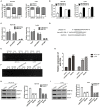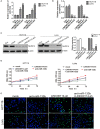Long Non-coding RNA LINC00114 Facilitates Colorectal Cancer Development Through EZH2/DNMT1-Induced miR-133b Suppression
- PMID: 31921641
- PMCID: PMC6928983
- DOI: 10.3389/fonc.2019.01383
Long Non-coding RNA LINC00114 Facilitates Colorectal Cancer Development Through EZH2/DNMT1-Induced miR-133b Suppression
Abstract
This study aimed to identify the roles of the long non-coding RNA LINC00114 in colorectal cancer (CRC) development. The expression levels of LINC00114 and miR-133b in CRC were determined by reverse transcription (RT)-polymerase chain reaction (PCR) and the functions of LINC00114 in CRC were evaluated in vitro and in vivo. Methylation-specific PCR assay was performed to detect the miR-133b promoter methylation in CRC cells. Bioinformatics analysis, RNA immunoprecipitation, dual luciferase assay, RNA pull-down, co-immunoprecipitation (IP), and chromatin IP (ChIP) assays were used to elucidate whether LINC00114 could recruit EZH2/DNMT1 and bind to the miR-133b promoter region, leading to dysregulated methylation and the depression of miR-133b. The expression levels of DNA methyltransferases (DNMTs), EZH2, and nucleoporin 214(NUP214) were analyzed by western blotting. Data showed that LINC00114 was highly expressed, whereas miR-133b was downregulated in the CRC tissues and cells. In vitro, silencing LINC00114 inhibited cell proliferation and impeded cell cycle at the G1/S phase by upregulating miR-133b. In vivo, LINC00114 knockdown reduced tumor growth. Further analysis showed that the methylation in miR-133b promoter region was increased in the CRC and silencing LINC00114 increased miR-133b expression through depressing methylation of its promoter region. ChIP-PCR experiments demonstrated that EZH2 and DNMT1 could bind to the miR-133b promoter region and it was abolished by LINC00114 knockdown. sh-EZH2 reversed the overexpression of DNMTs and CRC cell cycle progression induced by the LINC00114 upregulation. LINC00114 could regulate the NUP214 protein expression by sponging miR-133b. These results demonstrated that LINC00114 suppressed miR-133b expression via EZH2/DNMT1-mediated methylation of its promoter region, indicating that LINC00114 might be a potential novel target for CRC diagnosis and treatment.
Keywords: DNMT1; EZH2; LINC00114; colorectal cancer; methylation; miR-133b.
Copyright © 2019 Lv, He, Chen, Yu, Che, Tao, Wang, Jian and Zhang.
Figures







Similar articles
-
MiR-133b inhibits colorectal cancer metastasis via lncRNA-LUCAT1.Future Oncol. 2021 Mar;17(9):1013-1023. doi: 10.2217/fon-2020-0420. Epub 2021 Feb 5. Future Oncol. 2021. PMID: 33541136
-
Circ_0007031 enhances tumor progression and promotes 5-fluorouracil resistance in colorectal cancer through regulating miR-133b/ABCC5 axis.Cancer Biomark. 2020;29(4):531-542. doi: 10.3233/CBM-200023. Cancer Biomark. 2020. PMID: 32865180
-
DNMT1-induced miR-133b suppression via methylation promotes myocardial fibrosis after myocardial infarction.Gen Physiol Biophys. 2023 Sep;42(5):417-429. doi: 10.4149/gpb_2023018. Gen Physiol Biophys. 2023. PMID: 37702447
-
DNA methylation is involved in the aberrant expression of miR-133b in colorectal cancer cells.Oncol Lett. 2015 Aug;10(2):907-912. doi: 10.3892/ol.2015.3336. Epub 2015 Jun 8. Oncol Lett. 2015. PMID: 26622593 Free PMC article.
-
DNMT1 and EZH2 mediated methylation silences the microRNA-200b/a/429 gene and promotes tumor progression.Cancer Lett. 2015 Apr 10;359(2):198-205. doi: 10.1016/j.canlet.2015.01.005. Epub 2015 Jan 13. Cancer Lett. 2015. PMID: 25595591
Cited by
-
Epigenetic Mechanisms of LncRNAs Binding to Protein in Carcinogenesis.Cancers (Basel). 2020 Oct 11;12(10):2925. doi: 10.3390/cancers12102925. Cancers (Basel). 2020. PMID: 33050646 Free PMC article. Review.
-
Epigenetic silencing of KLF2 by long non-coding RNA SNHG1 inhibits periodontal ligament stem cell osteogenesis differentiation.Stem Cell Res Ther. 2020 Oct 7;11(1):435. doi: 10.1186/s13287-020-01953-8. Stem Cell Res Ther. 2020. PMID: 33028420 Free PMC article.
-
A Novel Signature Constructed by Immune-Related LncRNA Predicts the Immune Landscape of Colorectal Cancer.Front Genet. 2021 Aug 9;12:695130. doi: 10.3389/fgene.2021.695130. eCollection 2021. Front Genet. 2021. PMID: 34434220 Free PMC article.
-
Construction of a Novel MYC-Associated ceRNA Regulatory Network to Identify Prognostic Biomarkers in Colon Adenocarcinoma.J Oncol. 2022 Jul 5;2022:3216285. doi: 10.1155/2022/3216285. eCollection 2022. J Oncol. 2022. PMID: 35847359 Free PMC article.
-
Long non-coding RNA TMPO-AS1 promotes tumor progression via sponging miR-140-5p in breast cancer.Exp Ther Med. 2021 Jan;21(1):17. doi: 10.3892/etm.2020.9449. Epub 2020 Nov 5. Exp Ther Med. 2021. PMID: 33235626 Free PMC article.
References
LinkOut - more resources
Full Text Sources

